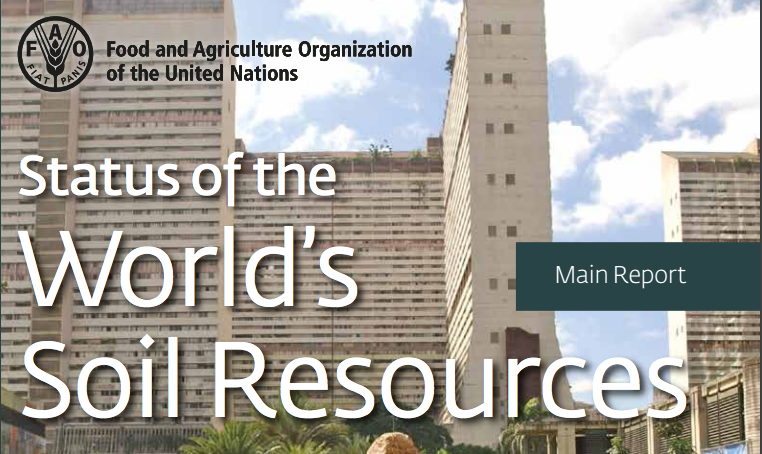Status of the Worlds Soil Resources
Author: FAO and ITPS | Published: 2015
1.1 | The World Soil Charter “Soils are fundamental to life on earth.”
We know more about soil than ever before, yet perhaps a smaller percentage of people than at any point in human history would understand the truth of this statement. The proportion of human labour devoted to working the soil has steadily decreased through the past century, and hence the experience of direct contact with the soil has lessened in most regions. Soil is very different in this regard from food, energy, water and air, to which each of us requires constant and secure access. Yet human society as a whole depends more than ever before on products from the soil as well as on the more intangible services it provides for maintenance of the biosphere.
Our goal in this report is to make clear these essential connections between human well-being and the soil, and to provide a benchmark against which our collective progress to conserve this essential resource can be measured.
The statement that begins this section is drawn from the opening sentence of the preamble of the revised World Soil Charter (FAO, 2015):
Soils are fundamental to life on Earth but human pressures on soil resources are reaching critical limits. Careful soil management is one essential element of sustainable agriculture and also provides a valuable lever for climate regulation and a pathway for safeguarding ecosystem services and biodiversity.
The World Soil Charter presents a series of nine principles that summarize our current understanding of the soil, the multi-faceted role it plays, and the threats to its ability to continue to serve these roles. As such, the nine principles form a succinct and comprehensive introduction to this report.
Principles from the World Soil Charter: Principle
1: Soils are a key enabling resource, central to the creation of a host of goods and services integral to ecosystems and human well-being. The maintenance or enhancement of global soil resources is essential if humanity’s overarching need for food, water, and energy security is to be met in accordance with the sovereign rights of each state over their natural resources. In particular, the projected increases in food, fibre, and fuel production required to achieve food and energy security will place increased pressure on the soil.
Principle 2: Soils result from complex actions and interactions of processes in time and space and hence are themselves diverse in form and properties and the level of ecosystems services they provide. Good soil governance requires that these differing soil capabilities be understood and that land use that respects the range of capabilities be encouraged with a view to eradicating poverty and achieving food security.
Principle 3: Soil management is sustainable if the supporting, provisioning, regulating, and cultural services provided by soil are maintained or enhanced without significantly impairing either the soil functions that enable those services or biodiversity. Status of the World’s Soil Resources | Main Report Global soil resources | 5 The balance between the supporting and provisioning services for plant production and the regulating services the soil provides for water quality and availability and for atmospheric greenhouse gas composition is a particular concern.
Principle 4: The implementation of soil management decisions is typically made locally and occurs within widely differing socio-economic contexts. The development of specific measures appropriate for adoption by local decision-makers often requires multi-level, interdisciplinary initiatives by many stakeholders. A strong commitment to including local and indigenous knowledge is critical.
Principle 5: The specific functions provided by a soil are governed, in large part, by the suite of chemical, biological, and physical properties present in that soil. Knowledge of the actual state of those properties, their role in soil functions, and the effect of change – both natural and human-induced – on them is essential to achieve sustainability.
Principle 6: Soils are a key reservoir of global biodiversity, which ranges from micro-organisms to flora and fauna. This biodiversity has a fundamental role in supporting soil functions and therefore ecosystem goods and services associated with soils. Therefore it is necessary to maintain soil biodiversity to safeguard these functions.
Principle 7: All soils – whether actively managed or not – provide ecosystem services relevant to global climate regulation and multi-scale water regulation. Land use conversion can reduce these global commongood services provided by soils. The impact of local or regional land-use conversions can be reliably evaluated only in the context of global evaluations of the contribution of soils to essential ecosystem services.
Principle 8: Soil degradation inherently reduces or eliminates soil functions and their ability to support ecosystem services essential for human well-being. Minimizing or eliminating significant soil degradation is essential to maintain the services provided by all soils and is substantially more cost-effective than rehabilitating soils after degradation has occurred.
Principle 9: Soils that have experienced degradation can, in some cases, have their core functions and their contributions to ecosystem services restored through the application of appropriate rehabilitation techniques. This increases the area available for the provision of services without necessitating land use conversion. These nine principles lead to guidelines for action by society (Box 1.1). The guidelines are introduced with a clear statement of our collective goal: ‘The overarching goal for all parties is to ensure that soils are managed sustainably and that degraded soils are rehabilitated or restored.’ This opening statement is followed by a series of specific guidelines for different segments of human society. Future updates of this report will document our success in implementation of these guidelines, and in achieving the goal set by the signatories of the World Soil Charter.

